
Triglochin is a plant genus in the family Juncaginaceae described by Carl Linnaeus in 1753. It includes 25 known species. It is very nearly cosmopolitan in distribution, with species on every continent except Antarctica. North America has four accepted species, two of which can also be found in Europe: Triglochin palustris and Triglochin maritima. Australia has many more.

Lanaria is a monotypic genus of flowering plants containing a single species, Lanaria lanata, endemic to the southern coast of South Africa where it is associated with the fynbos belt. Lanaria lanata is commonly known as Cape edelweiss or lambtails. The genus is placed in the monotypic family Lanariaceae, a family only recently recognized by taxonomists. The APG IV system of 2016 does recognize this family.
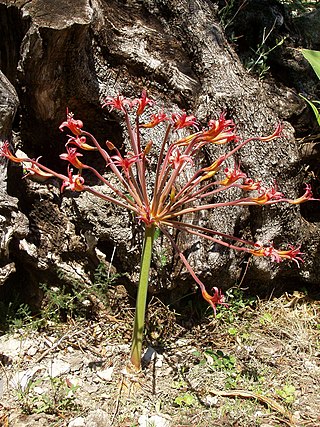
Brunsvigia is a genus of African flowering plants in the family Amaryllidaceae, subfamily Amaryllidoideae. It contains about 20 species native to southeastern and southern Africa from Tanzania to the Cape Provinces of South Africa.

The wildlife of South Africa consists of the flora and fauna of this country in southern Africa. The country has a range of different habitat types and an ecologically rich and diverse wildlife, vascular plants being particularly abundant, many of them endemic to the country. There are few forested areas, much savanna grassland, semi-arid Karoo vegetation and the fynbos of the Cape Floristic Region. Famed for its national parks and big game, 297 species of mammal have been recorded in South Africa, as well as 849 species of bird and over 20,000 species of vascular plants.

Bulbine is a genus of plants in the family Asphodelaceae and subfamily Asphodeloideae, named for the bulb-shaped tuber of many species. It was formerly placed in the Liliaceae. It is found chiefly in Southern Africa, with a few species extending into tropical Africa and a few others in Australia and Yemen.
Bulbine namaensis is a species of plant in the genus Bulbine. It is native to Namibia and to the Cape Provinces in South Africa. Its natural habitat is dry savanna.

Brabejum is a genus of a single species of large evergreen tree, Brabejum stellatifolium in the family Proteaceae, commonly called wild almond, bitter almond or ghoeboontjie. It is restricted in the wild to South Africa's Western Cape province, where it grows in thickets along the banks of streams. The plant is of botanical interest as being Africa's only member of the large grevilleoid subfamily. It is a bushy small tree with branches widely at ground level and numerous erect vigorous stems. Leaves grow up to 6 in (15 cm) long, narrow and bluntly toothed, appear at intervals along the branches, mostly in whorls of 6. In summer, the plant bears white flowers densely crowded on spikes arising from rusty buds at the leaf axils. The fruits to 2 in (5 cm) long, magenta to reddish brown, similar to an almond, appear in autumn. The nut is too bitter to eat; however, in earlier times it was boiled, roasted, and ground to make a "coffee" drink.

Rondebosch Common is an open common of about 40 hectares in Rondebosch, Cape Town in South Africa. A common is defined as "a piece of open land for public use, esp. in a village or town". It contains one of the few surviving pockets of the critically endangered “Cape Flats Sand Fynbos” vegetation type, which exists nowhere else in the world.

Aloiampelos commixta is a flowering plant in the Asphodelaceae family. It is commonly called Table Mountain aloe, and is a rare succulent plant that is endemic to the Cape Peninsula, South Africa. It naturally occurs only on the Table Mountain range, within the city of Cape Town.
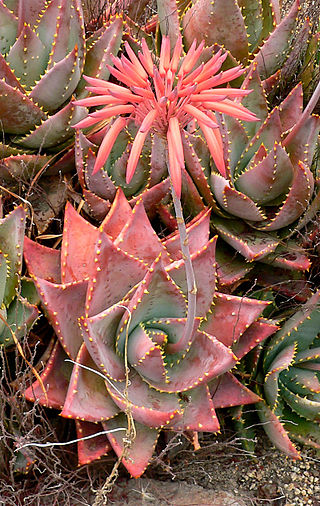
Aloe perfoliata, the rubble aloe or mitre aloe, is a hardy creeping aloe, found in rocky, mountainous areas throughout the Western Cape, South Africa.

Protea acaulos, also known as the common ground sugarbush, is a flowering plant found in the southwestern Cape Region, South Africa. It is also simply known as ground protea; in the Afrikaans language it is known as an aardroos.
Namaquanula is a plant genus in the Amaryllidaceae, found only in Namibia and the Cape Province of South Africa. There are 2 recognized species:

Haworthiopsis bruynsii, formerly Haworthia bruynsii, is a rare species of the genus Haworthiopsis in the family Asphodelaceae, endemic to a small area in the Eastern Cape Provinces in South Africa.

Bulbine cepacea is a flowering plant in the genus Bulbine, endemic to the Western Cape province, South Africa.
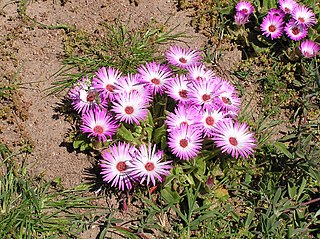
Cleretum is a genus of flowering plants in the family Aizoaceae, native to the Cape Provinces of South Africa.
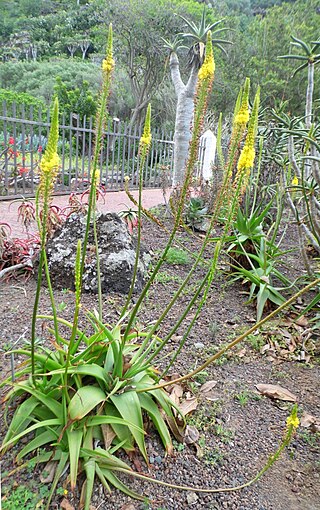
Bulbine alooides ("Rooistorm") is a species of geophytic plant in the genus Bulbine. It is endemic to South Africa, where it grows in the Cape Provinces, KwaZulu-Natal, and Northern Provinces. It is widespread in rocky areas in the southern Cape Region.
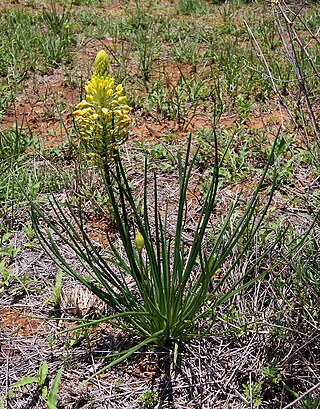
Bulbine abyssinica is a species of plant in the genus Bulbine, from eastern and southern Africa.

Bulbinella nutans is a species of plants in the family Asphodelaceae. It is found in the Cape Province of South Africa.

Bulbine praemorsa is a species of geophyte in the genus Bulbine. It is also known by the Afrikaans names Blougif, Slymstok, and Slymuintjie.
Bulbine lolita is a species of flowering plant in the family Asphodelaceae, native to the Knersvlakte region of the Northern Cape province of South Africa. It is the smallest known monocot succulent, measuring no more than 3/5ths inch wide by 1/4th inch in height. A recent discovery, it was unknown prior to 1999. It is also remarkable for its multicolored leaves.

















